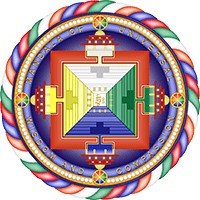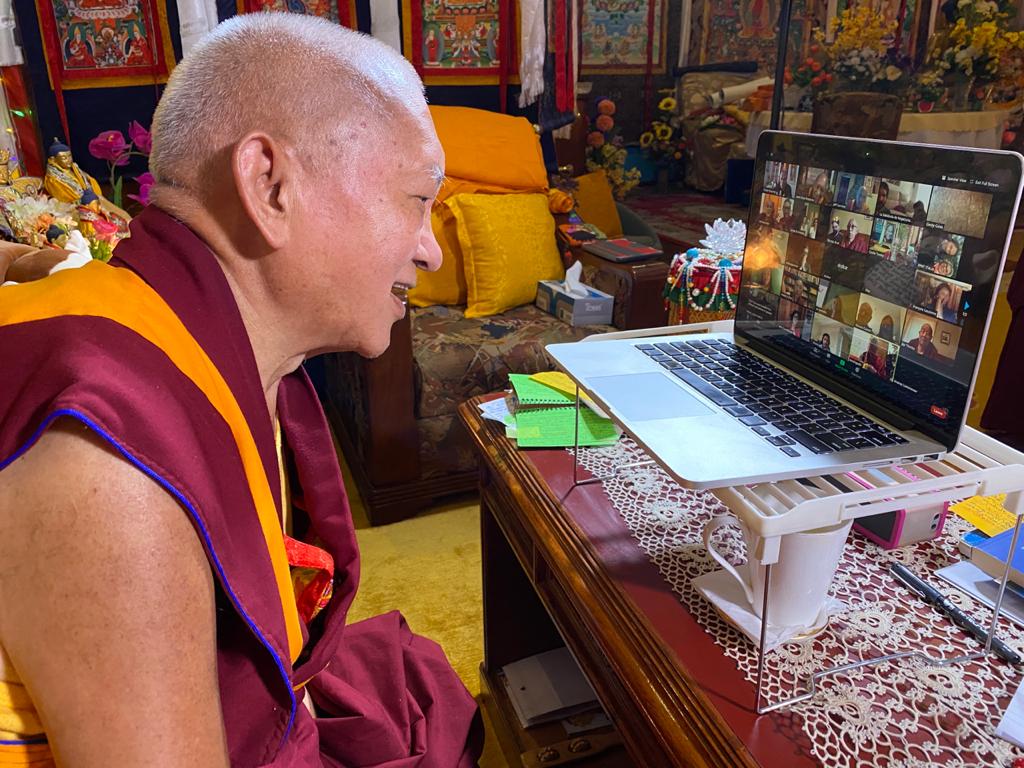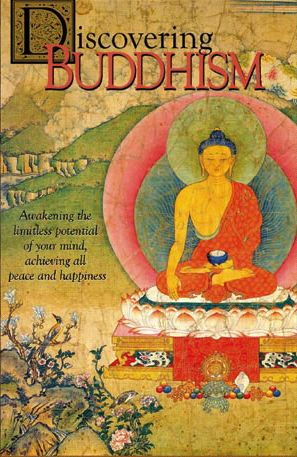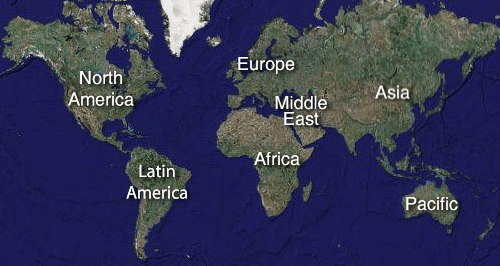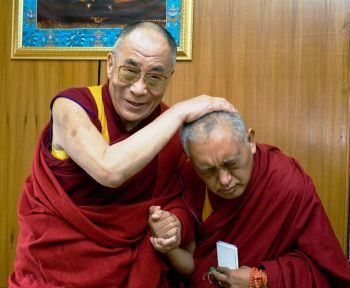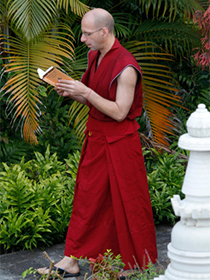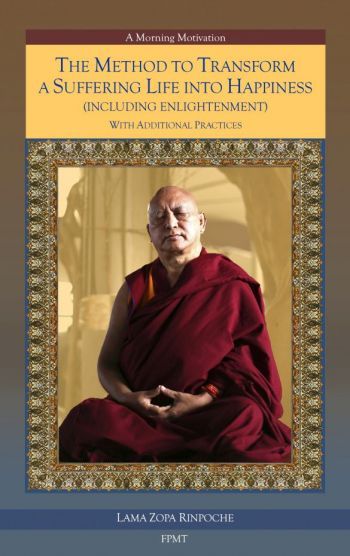- Home
- FPMT Homepage
Foundation for the Preservation of the Mahayana Tradition
The FPMT is an organization devoted to preserving and spreading Mahayana Buddhism worldwide by creating opportunities to listen, reflect, meditate, practice and actualize the unmistaken teachings of the Buddha and based on that experience spreading the Dharma to sentient beings. We provide integrated education through which people’s minds and hearts can be transformed into their highest potential for the benefit of others, inspired by an attitude of universal responsibility and service. We are committed to creating harmonious environments and helping all beings develop their full potential of infinite wisdom and compassion. Our organization is based on the Buddhist tradition of Lama Tsongkhapa of Tibet as taught to us by our founders Lama Thubten Yeshe and Lama Thubten Zopa Rinpoche.
- Willkommen
Die Stiftung zur Erhaltung der Mahayana Tradition (FPMT) ist eine Organisation, die sich weltweit für die Erhaltung und Verbreitung des Mahayana-Buddhismus einsetzt, indem sie Möglichkeiten schafft, den makellosen Lehren des Buddha zuzuhören, über sie zur reflektieren und zu meditieren und auf der Grundlage dieser Erfahrung das Dharma unter den Lebewesen zu verbreiten.
Wir bieten integrierte Schulungswege an, durch denen der Geist und das Herz der Menschen in ihr höchstes Potential verwandelt werden zum Wohl der anderen – inspiriert durch eine Haltung der universellen Verantwortung und dem Wunsch zu dienen. Wir haben uns verpflichtet, harmonische Umgebungen zu schaffen und allen Wesen zu helfen, ihr volles Potenzial unendlicher Weisheit und grenzenlosen Mitgefühls zu verwirklichen.
Unsere Organisation basiert auf der buddhistischen Tradition von Lama Tsongkhapa von Tibet, so wie sie uns von unseren Gründern Lama Thubten Yeshe und Lama Thubten Zopa Rinpoche gelehrt wird.
- Bienvenidos
La Fundación para la preservación de la tradición Mahayana (FPMT) es una organización que se dedica a preservar y difundir el budismo Mahayana en todo el mundo, creando oportunidades para escuchar, reflexionar, meditar, practicar y actualizar las enseñanzas inconfundibles de Buda y en base a esa experiencia difundir el Dharma a los seres.
Proporcionamos una educación integrada a través de la cual las mentes y los corazones de las personas se pueden transformar en su mayor potencial para el beneficio de los demás, inspirados por una actitud de responsabilidad y servicio universales. Estamos comprometidos a crear ambientes armoniosos y ayudar a todos los seres a desarrollar todo su potencial de infinita sabiduría y compasión.
Nuestra organización se basa en la tradición budista de Lama Tsongkhapa del Tíbet como nos lo enseñaron nuestros fundadores Lama Thubten Yeshe y Lama Zopa Rinpoche.
A continuación puede ver una lista de los centros y sus páginas web en su lengua preferida.
- Bienvenue
L’organisation de la FPMT a pour vocation la préservation et la diffusion du bouddhisme du mahayana dans le monde entier. Elle offre l’opportunité d’écouter, de réfléchir, de méditer, de pratiquer et de réaliser les enseignements excellents du Bouddha, pour ensuite transmettre le Dharma à tous les êtres. Nous proposons une formation intégrée grâce à laquelle le cœur et l’esprit de chacun peuvent accomplir leur potentiel le plus élevé pour le bien d’autrui, inspirés par le sens du service et une responsabilité universelle. Nous nous engageons à créer un environnement harmonieux et à aider tous les êtres à épanouir leur potentiel illimité de compassion et de sagesse. Notre organisation s’appuie sur la tradition guéloukpa de Lama Tsongkhapa du Tibet, telle qu’elle a été enseignée par nos fondateurs Lama Thoubtèn Yéshé et Lama Zopa Rinpoché.
Visitez le site de notre Editions Mahayana pour les traductions, conseils et nouvelles du Bureau international en français.
Voici une liste de centres et de leurs sites dans votre langue préférée
- Benvenuto
L’FPMT è un organizzazione il cui scopo è preservare e diffondere il Buddhismo Mahayana nel mondo, creando occasioni di ascolto, riflessione, meditazione e pratica dei perfetti insegnamenti del Buddha, al fine di attualizzare e diffondere il Dharma fra tutti gli esseri senzienti.
Offriamo un’educazione integrata, che può trasformare la mente e i cuori delle persone nel loro massimo potenziale, per il beneficio di tutti gli esseri, ispirati da un’attitudine di responsabilità universale e di servizio.
Il nostro obiettivo è quello di creare contesti armoniosi e aiutare tutti gli esseri a sviluppare in modo completo le proprie potenzialità di infinita saggezza e compassione.
La nostra organizzazione si basa sulla tradizione buddhista di Lama Tsongkhapa del Tibet, così come ci è stata insegnata dai nostri fondatori Lama Thubten Yeshe e Lama Zopa Rinpoche.
Di seguito potete trovare un elenco dei centri e dei loro siti nella lingua da voi prescelta.
- 欢迎 / 歡迎
简体中文
“护持大乘法脉基金会”( 英文简称:FPMT。全名:Foundation for the Preservation of the Mahayana Tradition) 是一个致力于护持和弘扬大乘佛法的国际佛教组织。我们提供听闻,思维,禅修,修行和实证佛陀无误教法的机会,以便让一切众生都能够享受佛法的指引和滋润。
我们全力创造和谐融洽的环境, 为人们提供解行并重的完整佛法教育,以便启发内在的环宇悲心及责任心,并开发内心所蕴藏的巨大潜能 — 无限的智慧与悲心 — 以便利益和服务一切有情。
FPMT的创办人是图腾耶喜喇嘛和喇嘛梭巴仁波切。我们所修习的是由两位上师所教导的,西藏喀巴大师的佛法传承。
繁體中文
護持大乘法脈基金會”( 英文簡稱:FPMT。全名:Found
ation for the Preservation of the Mahayana Tradition ) 是一個致力於護持和弘揚大乘佛法的國際佛教組織。我們提供聽聞, 思維,禪修,修行和實證佛陀無誤教法的機會,以便讓一切眾生都能 夠享受佛法的指引和滋潤。 我們全力創造和諧融洽的環境,
為人們提供解行並重的完整佛法教育,以便啟發內在的環宇悲心及責 任心,並開發內心所蘊藏的巨大潛能 — 無限的智慧與悲心 – – 以便利益和服務一切有情。 FPMT的創辦人是圖騰耶喜喇嘛和喇嘛梭巴仁波切。
我們所修習的是由兩位上師所教導的,西藏喀巴大師的佛法傳承。 察看道场信息:
- FPMT Homepage
- News/Media
-
- Study & Practice
-
-
- About FPMT Education Services
- Latest News
- Programs
- New to Buddhism?
- Buddhist Mind Science: Activating Your Potential
- Heart Advice for Death and Dying
- Discovering Buddhism
- Living in the Path
- Exploring Buddhism
- FPMT Basic Program
- FPMT Masters Program
- FPMT In-Depth Meditation Training
- Maitripa College
- Lotsawa Rinchen Zangpo Translator Program
- Universal Education for Compassion & Wisdom
- Online Learning Center
-
- Prayers & Practice Materials
- Overview of Prayers & Practices
- Full Catalogue of Prayers & Practice Materials
- Explore Popular Topics
- Benefiting Animals
- Chenrezig Resources
- Death & Dying Resources
- Lama Chopa (Guru Puja)
- Lama Zopa Rinpoche: Compendium of Precious Instructions
- Lama Zopa Rinpoche: Life Practice Advice
- Lama Zopa Rinpoche Practice Series
- Lamrim Resources
- Mantras
- Prayer Book Updates
- Purification Practices
- Sutras
- Thought Transformation (Lojong)
- Audio Materials
- Dharma Dates - Tibetan Calendar
- Translation Services
- Publishing Services
- Ways to Offer Support
- Prayers & Practice Materials
-
- Teachings and Advice
- Find Teachings and Advice
- Lama Zopa Rinpoche Advice Page
- Lama Zopa Rinpoche: Compendium of Precious Instructions
- Lama Zopa Rinpoche Video Teachings
- ༧སྐྱབས་རྗེ་བཟོད་པ་རིན་པོ་ཆེ་མཆོག་ནས་སྩལ་བའི་བཀའ་སློབ་བརྙན་འཕྲིན།
- Podcasts
- Lama Yeshe Wisdom Archive
- Buddhism FAQ
- Dharma for Young People
- Resources on Holy Objects
- Teachings and Advice
-
-
*If a menu item has a submenu clicking once will expand the menu clicking twice will open the page.
-
-
- Centers
-
- Teachers
-
- Projects
-
-
-
-
*If a menu item has a submenu clicking once will expand the menu clicking twice will open the page.
-
-
- FPMT
-
-
-
-
-
Superficial observation of the sense world might lead you to believe that people’s problems are different, but if you check more deeply, you will see that fundamentally, they are the same. What makes people’s problems appear unique is their different interpretation of their experiences.
Lama Thubten Yeshe
-
-
-
- Shop
-
-
-
The Foundation Store is FPMT’s online shop and features a vast selection of Buddhist study and practice materials written or recommended by our lineage gurus. These items include homestudy programs, prayers and practices in PDF or eBook format, materials for children, and other resources to support practitioners.
Items displayed in the shop are made available for Dharma practice and educational purposes, and never for the purpose of profiting from their sale. Please read FPMT Foundation Store Policy Regarding Dharma Items for more information.
-
-
Lama Zopa Rinpoche News and Advice
24

Lama Zopa Rinpoche blessing a dog at an animal blessing in Moscow, Russia, 2019. Photo by Ven. Lobsang Sherab.
The following video is an Essential Extract from Lama Zopa Rinpoche. Essential Extracts are short videos extracted from a longer teachings that focus on a specific topic. We have more than two hundred Essential Extract videos available on our website. We also routinely share these Essential Extract videos in blog posts, which include transcripts and links to additional materials. Here is a short Essential Extract on the importance of providing Dharma imprints for our pets.
In this video, Lama Zopa Rinpoche tells a story about a dog from Tushita Meditation Centre in Dharamsala that he gave to a woman in Delhi. Rinpoche asked her to recite a lamrim prayer and mantra to the dog, which she did. Rinpoche praises her so much for doing this every day. Hearing the prayers saves the dog from the lower realms, frees it from samsara, and brings it to enlightenment. Therefore, this is also what we need to do for our own beloved pets!
Watch the Essential Extract “Just Giving Food and Shelter to Our Pets Is Not Enough”:
Read the transcript of this video extract from Rinpoche’s teaching:
https://fpmt.box.com/s/rair1ijp8zlrwui3nuw7afcwhdc2p0oi
Find more advice and resources for helping pets on our Benefiting Animals page:
https://fpmt.org/education/prayers-and-practice-materials/benefiting-animals-practices-and-advice/
You can find more blogs with short video clips from Rinpoche’s teaching as well as the complete collection of these “Essential Extracts” videos on FPMT.org.
Lama Zopa Rinpoche is the spiritual director of the Foundation for the Preservation of Mahayana Tradition (FPMT), a Tibetan Buddhist organization dedicated to the transmission of the Mahayana Buddhist tradition and values worldwide through teaching, meditation and community service.
- Tagged: advice from lama zopa rinpoche, animals, essential extract, essential extract thought transformation teachings, taking care of animals, video
22

Lama Zopa Rinpoche with the geshes and geshemas who teach philosophy at Kopan Monastery and Nunnery, senior nuns, some Kopan staff, and a few lay students at the Chandragiri Hill Resort, Nepal, November 2021. Photo by Ven. Lobsang Sherab.
The following video is an Essential Extract from Lama Zopa Rinpoche. Essential Extracts are short videos extracted from longer teachings that focuses on a specific topic. We have more than two hundred Essential Extract videos available on our website. We also routinely share these Essential Extract videos in blog posts, which include transcripts and links to additional materials. Here is a short Essential Extract on the bravery of ordained sangha.
In this video, Lama Zopa Rinpoche explains how ordained monks and nuns, the sangha, are real heroes. They are incredibly brave because they are conquering the delusions that have kept us in samsara from beginningless rebirths. Each sangha member has been a hero for however many years, months, and weeks they have been ordained.
Rinpoche explains that the numberless buddhas and bodhisattvas are happy with us for conquering delusions and are helping us, but we have to do the work. We have to recognize that delusion is the real enemy. Delusion has been defeating us from beginningless rebirths, but now we defeat delusion! That is Dharma practice. That is real Dharma.
Watch the video “The Sangha Are Real Heroes Because They Are Defeating Delusion”:
Read the transcript of Rinpoche’s teaching:
https://fpmt.box.com/s/il1h3stjbenp9uzxm7t8n10xj1wgzb6z
Learn more about FPMT ordained sangha:
https://fpmt.org/centers/sangha/
The above video is extracted from the Thought Transformation Teaching video recorded on July 12, 2020, at Kopan Monastery in Nepal. You can find more blogs with short video clips from Rinpoche’s teaching as well as the complete collection of these “Essential Extracts” videos on FPMT.org.
Watch videos from the series Lama Zopa Rinpoche’s Teachings on Thought Transformation and find links to transcripts, MP3s, additional practice advice, and more. Read an in-depth summary of Rinpoche’s thought transformation teachings given in 2020 in the Mandala 2021 article “The Time to Practice Is Now.”
Lama Zopa Rinpoche is the spiritual director of the Foundation for the Preservation of Mahayana Tradition (FPMT), a Tibetan Buddhist organization dedicated to the transmission of the Mahayana Buddhist tradition and values worldwide through teaching, meditation and community service.
- Tagged: advice from lama zopa rinpoche, essential extract, essential extract thought transformation teachings, sangha, video
11
The Karma of Killing
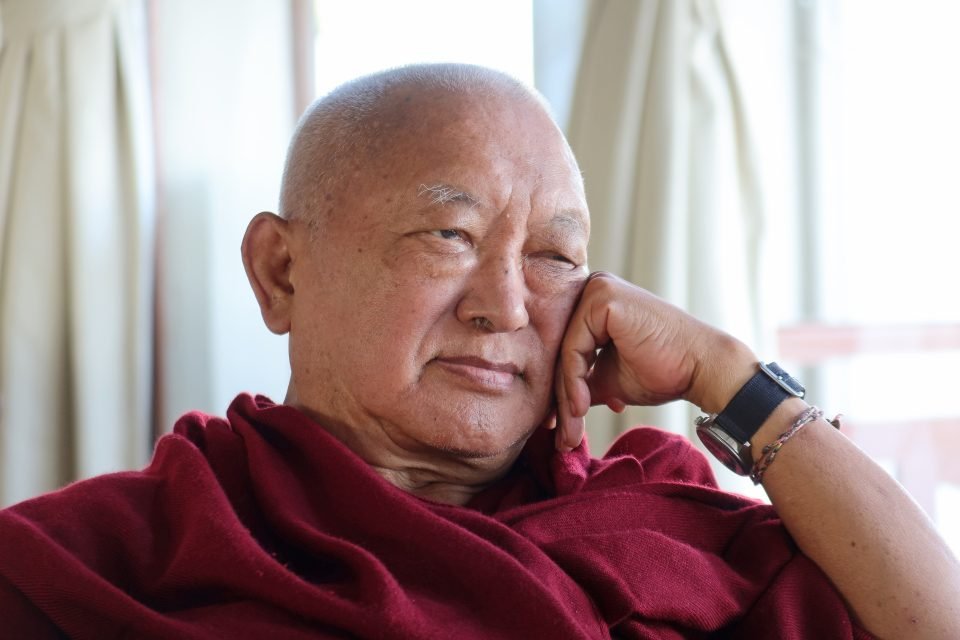
Lama Zopa Rinpoche, Pokhara, Nepal, December 2021. Photo by Ven. Roger Kunsang.
The following video is an Essential Extract from Lama Zopa Rinpoche. Essential Extracts are short videos extracted from a longer teachings that focuses on a specific topic. We have more than two hundred Essential Extract videos available on our website. We also routinely share these Essential Extract videos in blog posts, which include transcripts and links to additional materials. Here is a short Essential Extract on the karma of killing.
In this short video, Lama Zopa Rinpoche comments on how sad it is that there are children who kill snakes to make a living. Rinpoche reminds us that anyone who kills even one sentient being, will have to experience the four suffering karmic results of killing.
Rinpoche explains the karmic results of killing in the following way:
- The complete negative karma of killing a snake has the ripened-aspect result of rebirth in hell, in the lower realms.
- The possessed result is that even when good karma ripens and you are reborn as a human being, you still suffer and have many problems in life, including dangers of death, because of killing a snake. You live in places where there are a lot of contagious diseases, obstacles to your health, and so forth.
- There is experiencing the result similar to the cause. This is when others kill you as the result of the past karma of killing the snake.
- There is creating the result similar to the cause. As a result of the past negative karma of killing a snake, even if it was just once, you want to kill again. You created a habit for killing. Then when you kill again, the negative karma created has the four suffering results again. So it goes on and on, on and on. It makes endless suffering of samsara.
Lama Zopa Rinpoche stresses how it is therefore sooooooo important and even urgent to abandon committing the ten non-virtues, including killing, and to practice Dharma.
Watch the video “Karma of Children Who Kill Snakes”:
Read the transcript of Rinpoche’s teaching:
https://fpmt.box.com/s/3e5nqxh8s39xs8nfstae1cv4km2z5e07
The above video is extracted from a Thought Transformation Teaching video recorded on December 9, 2020, at Kopan Monastery in Nepal. You can find more blogs with short video clips from Rinpoche’s teaching as well as the complete collection of these “Essential Extracts” videos on FPMT.org.
Watch videos from the series Lama Zopa Rinpoche’s Teachings on Thought Transformation and find links to transcripts, MP3s, additional practice advice, and more. Read an in-depth summary of Rinpoche’s thought transformation teachings given in 2020 in the Mandala 2021 article “The Time to Practice Is Now.”
Lama Zopa Rinpoche is the spiritual director of the Foundation for the Preservation of Mahayana Tradition (FPMT), a Tibetan Buddhist organization dedicated to the transmission of the Mahayana Buddhist tradition and values worldwide through teaching, meditation and community service.
- Tagged: advice from lama zopa rinpoche, essential extract, essential extract thought transformation teachings, karma, video
9
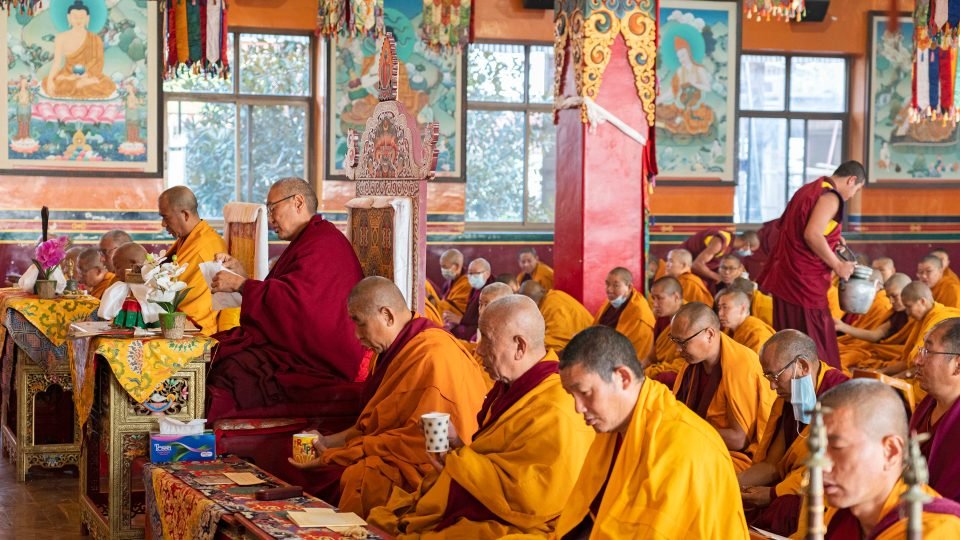
Sangha from Kopan Monastery and Khachoe Ghakyil Nunnery doing prayers and practices in preparation for the long life puja for Lama Zopa Rinpoche, Kopan Monastery, Nepal, March 2022. Photo by Ven. Lobsang Sherab.
A White Tara long life puja will be offered to FPMT Spiritual Director Lama Zopa Rinpoche on March 11, 2022, at Kopan Monastery in Nepal. Currently, the monks and nuns from Kopan Monastery and Khachoe Ghakyil Nunnery are doing seven days of practice in preparation for this special long life puja.
A long life puja offered to one’s teacher is a powerful opportunity to show devotion. The heartfelt prayers and praises along with the procession of symbolic offerings made to a spiritual guide create extensive merit. In addition, one is able to purify the mistakes that occur in relation to a teacher and to create the causes and conditions to continue to receive benefit from that teacher for a very long time. And, as Lama Zopa Rinpoche regularly mentions, offering long life pujas is a cause for one’s own long life.
We are pleased to share a short video of the long life puja preparations at Kopan Monastery:
The long life puja on March 11 will be offered to Lama Zopa Rinpoche on behalf of the entire FPMT organization. Our prayers have tremendous power, and we invite you to join us by rejoicing in the puja being offered, generating your own prayers for Rinpoche’s health and long life, or making an offering toward the expenses associated with the pujas and practices for Rinpoche’s health and long life.
Lama Zopa Rinpoche is the spiritual director of the Foundation for the Preservation of Mahayana Tradition (FPMT), a Tibetan Buddhist organization dedicated to the transmission of the Mahayana Buddhist tradition and values worldwide through teaching, meditation and community service.
Visit our Long Life Puja Fund page to learn more about the purpose of long life pujas and opportunities to offer support for them.
For additional recent advice on mantra recitations to do for Lama Zopa Rinpoche, His Holiness the Dalai Lama, and the entire FPMT organization see:
fpmt.org/lama-zopa-rinpoche-news-and-advice/mantra-recitations-for-his-holiness-the-dalai-lama-lama-zopa-rinpoche-and-fpmt
- Tagged: lama zopa rinpoche long life puja, long life puja, long life puja for lama zopa rinpoche, long life puja fund, video short
8
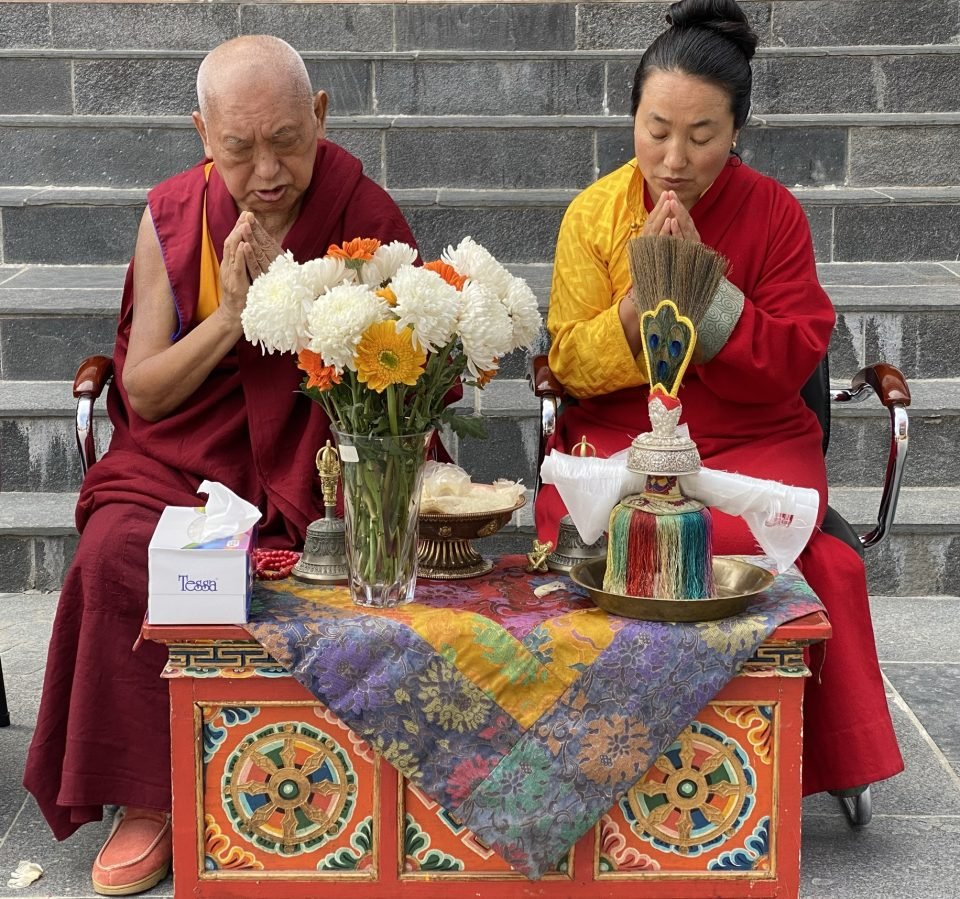
Lama Zopa Rinpoche and Khadro-la during the consecration of large appliqué Twenty-one Taras thangkas and the Eight Taras That Save from Fear thangkas outside Kopan Gompa, Kopan Monastery, Nepal, January 2021. Photo by Ven. Roger Kunsang.
In the new book The Power of Mantra: Vital Practices for Transformation, Lama Zopa Rinpoche guides students through understanding the power and benefit of mantras. Rinpoche explains many popular mantras, giving specific instructions for practicing them, including Shakyamuni Buddha, Chenrezig, Manjushri, Tara, Medicine Buddha, Vajrasattva, and more. In an excerpt from the chapter on Tara mantra, Rinpoche discusses Mother Tara:
The benefits of practicing Tara are uncountable. By reciting the Praises to the Twenty-One Taras with devotion, at dawn or dusk, and remembering Tara and reciting her mantra at any time of the day or night, we are protected from fear and danger, and all our wishes are fulfilled. If we pray to Tara, Tara will grant help quickly.
She is especially quick in granting us success in obtaining the ultimate happiness of enlightenment, but there are also many temporal benefits of reciting the Tara mantra or the Praises to the Twenty-One Taras prayer. Tara can solve many problems in life: liberating us from untimely death, helping us recover from disease, bringing us success in business. Somebody with a serious problem, such as a life-threatening disease, who relies on Tara will very commonly be freed from that problem. For instance, His Holiness the Dalai Lama encouraged us to recite Tara’s mantra as a protection for ourselves and others against the coronavirus COVID-19.
Pabongka Dechen Nyingpo tells a story of one of his students who didn’t know much Dharma but had faith in Tara and so received help from her, but not as much as he might have. One day during his journey to Mongolia, while walking along reciting Tara prayers, he heard a dog barking and saw a tent. Because he needed some water to quench his thirst, he went there, where he saw a young girl, alone, tending many yaks. Seeing the monk was weak and hungry, she insisted he stay with her for a few days and she fed him. When it was time to leave, she gave him some tsampa and other food. Because he was completely lost, she gave him very explicit directions on how to get to his destination and, as he was leaving, she gave him a large bunch of grass. She explained that when he awoke each morning, he should drop some grass on the ground and head in whichever direction it fell.
He only had a little food, enough for a day or two, but each day, when he opened the sack, his food was never depleted. Following the directions the girl had given him, he managed to find his way to his destination. When he looked in his sack at the very end of his journey, there was not one speck of food left. He was so surprised with this that he sent a letter to his guru, Pabongka Rinpoche, in Lhasa. Rinpoche wrote back and said that it was a pity he hadn’t followed the girl’s instructions completely. If he had, he would have been in a pure realm already. That yak herder was a manifestation of Tara, but he was unable to see this. Tara manifests in many aspects, not just the green and white forms that are commonly depicted.
Tara is like our mother. Take my mother as an example. She did all the work while the rest of us—there were three of us—were useless. One day, she had to go into the forest to get the firewood. Because none of us could make food, we waited outside the door for her to return so we could eat. When she came back very late with a very heavy load of firewood, she could not make a fire because she was sick. She lay down next to the fireplace in so much pain. There was no fire in the stove and no food. She was screaming, calling for her mother: “Ama! Ama!” (My grandmother, who was still alive at that time, lived quite near.) Because none of us could make one, there was no fire; we just sat and watched our mother. Even adults call for their mother when they have bad pain or a serious problem. However, Tara is much closer to us than a mother, and she is quick to grant us help and protect us from danger.
The Praises to the Twenty-One Taras begins, “I prostrate to the noble transcendent liberator.” That means that Tara herself is completely liberated from the whole of samsara and the cause of samsara through having completed the both the method and wisdom sides of the practice. Not only that, by having overcome the two obscurations, gross and subtle, she is also free from being bound to lower nirvana. Liberated from both samsara and the peace of lower nirvana means she is fully enlightened. And because she in turn liberates all of us, allowing us to attain full enlightenment, she is called Tara the Liberator, the mother who liberates.
From The Power of Mantra: Vital Practices for Transformation by Lama Zopa Rinpoche; compiled and edited by Gordon McDougall; published by Wisdom Publications (WisdomExperience.org), where you can order the paperback or digital versions of the book. You can also find the ebook and PDF version in the Foundation Store (shop.fpmt.org).
Find more resources for your Tara practice as well as recent advice on mantra practices for His Holiness the Dalai Lama and Lama Zopa Rinpoche on our website (FPMT.org).
Lama Zopa Rinpoche is the spiritual director of the Foundation for the Preservation of Mahayana Tradition (FPMT), a Tibetan Buddhist organization dedicated to the transmission of the Mahayana Buddhist tradition and values worldwide through teaching, meditation and community service.
- Tagged: 21 taras, lama zopa rinpoche, mantra, wisdom publications
4
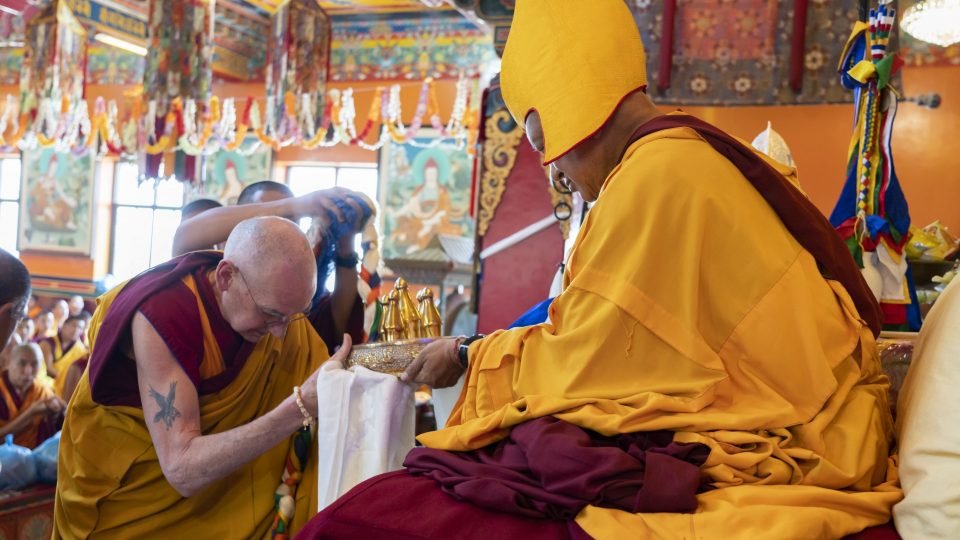
Ven. Roger Kunsang offering a mandala to Lama Zopa Rinpoche during the April 19, 2021 long life puja at Kopan Monastery
Every year Ven. Roger Kunsang, on behalf of the FPMT organization, checks with Lama Zopa Rinpoche’s gurus and/or Rangjung Neljorma Khadro Namsel Drönme (Khadro-la), to determine what practices should be done to help create the conditions for Lama Zopa Rinpoche to have a long life and good health for the coming year.
The first offering to Rinpoche arranged this year will be a White Tara long life puja on March 11, 2022, at Kopan Monastery. This special long life puja will involve seven days of preparation led by Khadro-la with the Kopan monks. At a later date there will be a Most Secret Hayagriva tsog kong and a Guru Rinpoche bum tsog also offered according to the advice received.
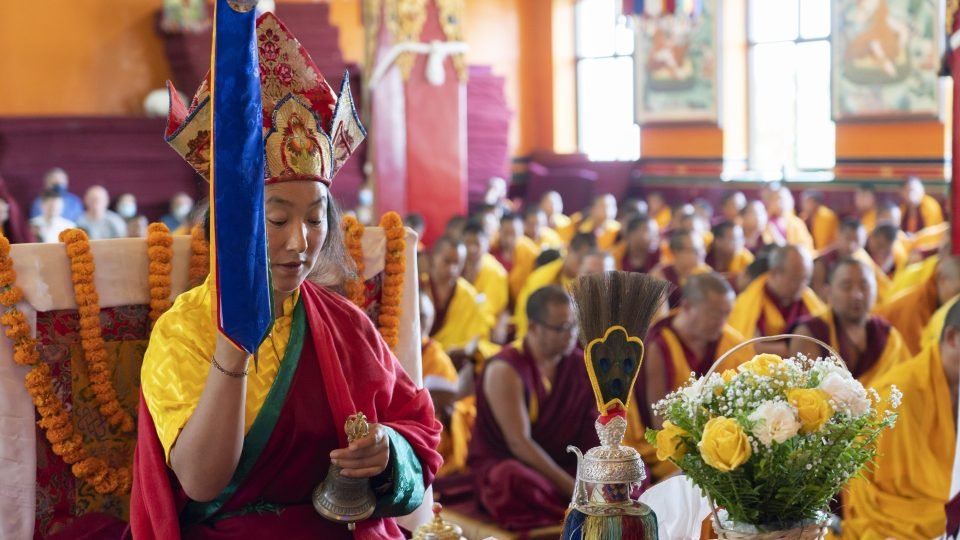
Khadro-la making an offering during a long life puja to Lama Zopa Rinpoche, April 2021. Photo by Ven. Lobsang Sherab.
Our prayers have tremendous power and we invite you to join us by rejoicing in the puja being offered, generating your own prayers for Rinpoche’s health and long life, or making an offering toward the expenses associated with the pujas and practices for Rinpoche’s health and long life.
For additional recent advice from Khadro-la on mantra recitations to do for Lama Zopa Rinpoche, His Holiness the Dalai Lama, and the entire FPMT organization see: fpmt.org/lama-zopa-rinpoche-news-and-advice/mantra-recitations-for-his-holiness-the-dalai-lama-lama-zopa-rinpoche-and-fpmt
Lama Zopa Rinpoche is the spiritual director of the Foundation for the Preservation of Mahayana Tradition (FPMT), a Tibetan Buddhist organization dedicated to the transmission of the Mahayana Buddhist tradition and values worldwide through teaching, meditation and community service.
The Long Life Puja Fund always contributes to long life pujas offered to Lama Zopa Rinpoche. You can also learn about the many Charitable Projects of FPMT and discover how the various funds and projects are benefiting others.
1
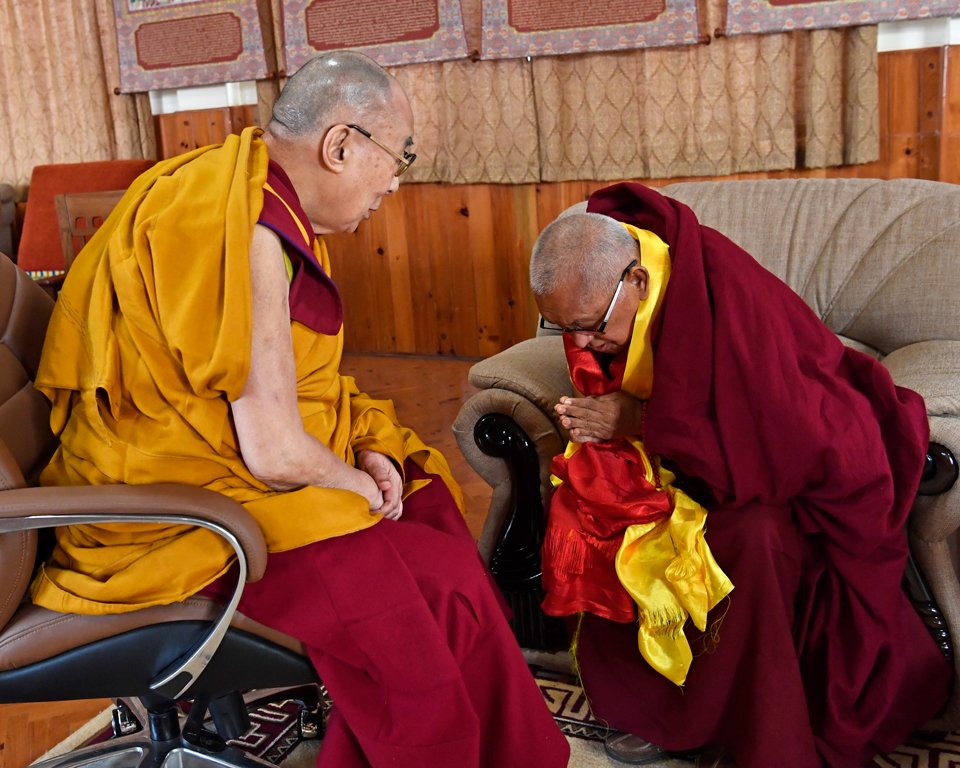
His Holiness the Dalai Lama meeting with Lama Zopa Rinpoche, Bodhgaya, India, January 2020. Photo courtesy of the Office of His Holiness the Dalai Lama.
At the beginning of each Tibetan year, Ven. Roger Kunsang requests advice for Lama Zopa Rinpoche’s health and the success of the FPMT organization. This year Rangjung Neljorma Khadro Namsel Dronme (Khadro-la) has advised that it would be extremely beneficial if FPMT students can recite Chenrezig and White Tara mantras for His Holiness the Dalai Lama and Lama Zopa Rinpoche’s health, for the fulfilment of all their wishes, and for the benefit of all in the FPMT organization.
The request is to recite these mantras during the most meritorious period starting with Losar (March 3), and up to and including the last of the Days of Miracles, Chotrul Duchen, on March 18. Please dedicate using the FPMT dedication prayers (in the FPMT Essential Prayer Book and Complete Dedication Prayer Book), including the long life prayer for His Holiness the Dalai Lama.
Whether you are doing them individually or as part of a group at your local center, project, or service; please keep track of the numbers of mantras you complete. You can send your individual recitation numbers on March 19 to Claire Isitt, and if you are connected to a local FPMT center, please send them your recitation numbers. Ven. Roger will then offer that accumulation of meritorious activity to Lama Zopa Rinpoche on behalf of us all.
- Chenrezig mantra:
OM MANI PADME HŪM (link to a short practice from Education Services)
- White Tara mantra:
OM TĀRE TUTTĀRE TURE MAMA ĀYUR PUṆYE JÑĀNA PUSHTIM KURUYE SVĀHĀ (link to a short meditation from Education Services)
These practices are in addition to the long life puja being offered to Lama Zopa Rinpoche on March 11 (with seven days of preparatory pujas being offered). We will send more details and a reminder about this auspicious long life puja at the end of the week.
His Holiness the 14th the Dalai Lama, Tenzin Gyatso, is the spiritual leader of the Tibetan people.
Lama Zopa Rinpoche is the spiritual director of the Foundation for the Preservation of Mahayana Tradition (FPMT), a Tibetan Buddhist organization dedicated to the transmission of the Mahayana Buddhist tradition and values worldwide through teaching, meditation and community service.
25
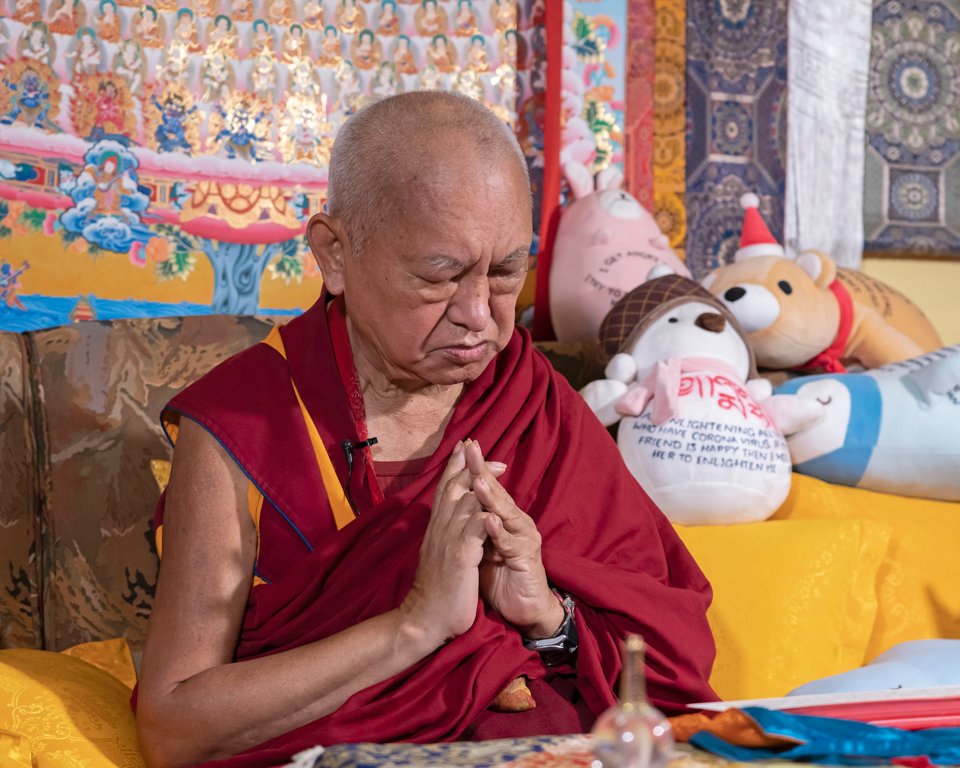
Lama Zopa Rinpoche making prayers, at Kopan Monastery, March 2021. Photo by Ven. Lobsang Sherab.
Lama Zopa Rinpoche has given the following advice regarding practices to do in response to the current situation in Ukraine at this time, to reduce the war and to help stop the violence and suffering. Rinpoche has also already arranged a number of powerful pujas, such as controlling fire puja, wrathful fire pujas, and Drugchuma (Sixty-Four Offerings to Kalarupa).
With a bodhicitta motivation and strong dedication, Rinpoche is advising the following practices:
- Recitation of “Padmasambhava—The Prayer to Guru Rinpoche that Spontaneously Fulfills All Wishes” (Sampa Lhundrupma) | Download
- Recitation of “Padmasambhava—The Supplication to Guru Rinpoche Clearing the Obstacles on the Path” (Barchey Lamsel) | Download
- Recitation of White Umbrella practice
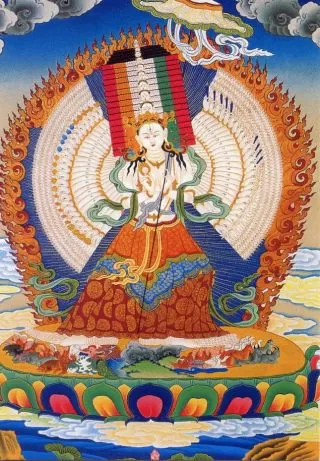
White Umbrella deity.
General Motivation:
The ultimate purpose of my life is to do perfect work for others. In order to fulfill that purpose, it is necessary for me to achieve the state of full enlightenment, omniscient mind, and in order to do that, I must actualize the path to enlightenment. Therefore, I am going to do actions that become only causes for me to achieve enlightenment and to bring all sentient beings to enlightenment as quickly as possible. May all my actions become only causes for me to achieve enlightenment and to bring all sentient beings to enlightenment as quickly as possible.
General Dedications:
To Actualize Bodhicitta
Due to all the past, present, and future merits collected by me and all the merits of the three times collected by numberless buddhas and numberless sentient beings, may bodhicitta be generated in the hearts of all the sentient beings of the six realms, and especially in the hearts of everybody in this world, including all the students, benefactors, and volunteers in the FPMT organization. May it be generated in the hearts of all those who rely upon me, all those for whom I have promised to pray, and all those whose names have been given to me. May it be generated in my heart
For Peace and Happiness to Prevail in the World
Due to all the past, present, and future merits collected by me, the numberless buddhas, and the numberless sentient beings, may all wars—particular the current situation in Ukraine—famines, diseases, global problems, and all dangers of earth, water, fire, and wind be stopped immediately. May perfect peace and happiness prevail in everyone’s hearts by their generating loving kindness, compassion, and bodhicitta. May the Buddhadharma, from where sentient beings receive peace and happiness, last a long time and spread in all directions. May all sentient beings meet the Buddhadharma and achieve enlightenment as quickly as possible.
To Seal the Merits with Emptiness
Due to all the past, present, and future merits collected by me, the numberless buddhas, and the numberless sentient beings, which are completely empty of existing from their own side, may I, who am completely empty of existing from my own side, achieve the state of full enlightenment, which is completely empty of existing from its own side, and lead all sentient beings, who are completely
empty of existing from their own side, to that state, which is completely empty of existing from its own side, by myself alone, who am completely empty of existing from my own side.
To Dedicate in the Same Way as All the Past Buddhas
and Bodhisattvas
I fully dedicate all these virtues
To be able to train just like
The hero Mañjuśrī, who knows reality,
And just like Samantabhadra as well.
I fully dedicate all my roots of virtue,
With the dedication praised as the best
By all the gone-beyond victorious ones of the three times
In order to have good conduct.
Motivation and dedications taken from A Daily Meditation on Shakyamuni Buddha, by Lama Zopa Rinpoche.
Valuable and timely advice from Lama Zopa Rinpoche can be found on Rinpoche’s advice page.
Lama Zopa Rinpoche is the spiritual director of the Foundation for the Preservation of Mahayana Tradition (FPMT), a Tibetan Buddhist organization dedicated to the transmission of the Mahayana Buddhist tradition and values worldwide through teaching, meditation and community service.
25
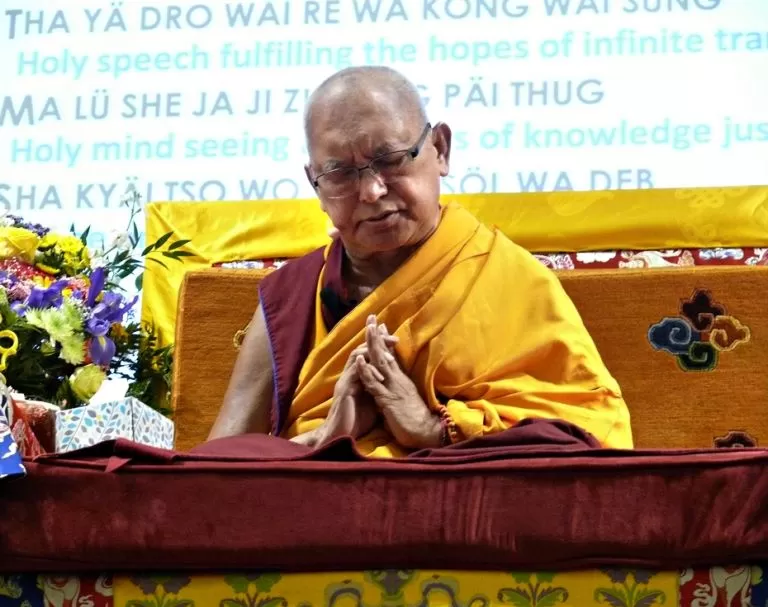
Lama Zopa Rinpoche at Light of the Path, Black Mountain, North Carolina, US, September 2017. Photo by Kalleen Mortensen.
Lama Zopa Rinpoche led the first Light of the Path retreat in 2009 in North Carolina, US, hosted by Kadampa Center. The last retreat was in 2017 and the next highly anticipated retreat is this year, August 14 – 28 2022!
Kadampa Center shares this important update:
The Light of the Path Retreat is returning this year (August 14-28) , in a new model that we hope will allow students all over the world to hear Lama Zopa Rinpoche’s precious teachings together.
We have requested Rinpoche to teach each day, for approximately two hours, beginning at around 8 p.m. Nepal time. You will be able to find Rinpoche’s teaching time for your local time zone.
We are putting the finishing touches on a hybrid retreat, with both online and in-person opportunities. As we get closer to August, we will share our schedule and offer some suggestions for designing schedules for personal retreat.
We have invited retreat and residential centers from around the world to hold in-person retreats on their home sites, so that retreatants can experience true retreat in person and in community with other students. We are still working out the details with several centers; watch for more news about where to attend the retreat in person!
We also encourage students who are unable to attend in person to take this time off work and do retreat from home, following the teachings, prayers, and practices online. Some students are forming “pods” to rent space and do retreat in person together in small groups.
We expect to open registration in March. Watch for more information as we finalize the details.
We recommend that students prepare for Light of the Path 2022 by reviewing Rinpoche’s teachings in previous Light of the Path retreats.
Please refer to Kadampa Center’s website for registration details in March.
FPMT.org and Mandala Publications brings you news of Lama Zopa Rinpoche and of activities, teachings, and events from 150 FPMT centers, projects, and services around the globe. If you like what you read, consider becoming a Friend of FPMT, which supports our work.
- Tagged: light of the path, light of the path 2022
24
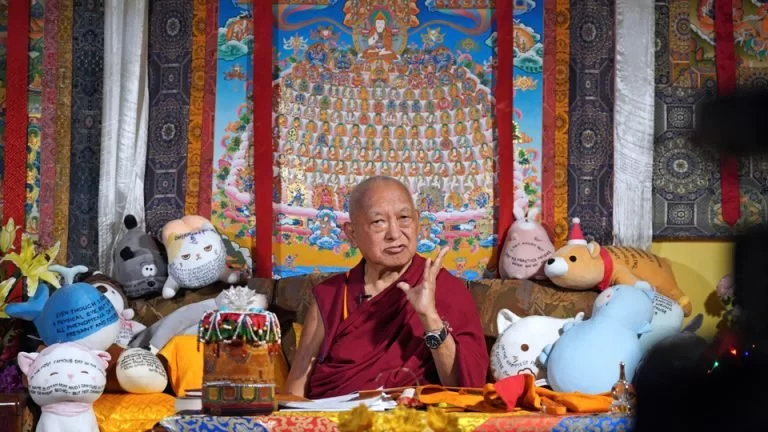
Lama Zopa Rinpoche teaching on make offerings on the anniversary of the guru’s passing away, Kopan Monastery, Nepal, March 2021. Photo by Ven. Lobsang Sherab.
Last year, Lama Zopa Rinpoche translated and commented on a short Tibetan text during his ongoing thought transformation teachings. The text explains the importance of making offerings on the anniversary of the passing away of one’s guru. Rinpoche’s translation and commentary have now been published in the booklet Advice for the Anniversary of the Guru’s Passing Away, available from the Foundation Store.
The new booklet is being offered to inspire students and centers to do practices, such as Lama Chopa with Tsog Offering, on Losar, the Tibetan New Year, in relation to Lama Yeshe, who founded the FPMT organization with his heart disciple Lama Zopa Rinpoche. Losar is of special significance to the FPMT community as it marks the anniversary of the passing of Lama Yeshe.
Rinpoche praised his beloved teacher last year from Kopan Monastery:
“Lama Yeshe, whose holy name is extremely difficult to mention and whose kindness is difficult to express, took the aspect of passing away early in the morning of the first day of the Tibetan New Year (Losar) in 1984. I was with Lama for many years and all the FPMT centers, as well as several schools and hospices, were started by him.
“I have been meaning to explain for some time what to do on the anniversary of Lama Yeshe’s passing away (gong dzog) but it didn’t happen until now. As explained in the text, A Hundred Clear Realizations of the Glorious One from Narthang by Namkha Drag, you should make offerings on that day by, for example, doing Lama Chopa and Tsog Offering. You can also do the same on the anniversary of the passing away of your other lamas, such as Choden Rinpoche and Ribur Rinpoche. Making offerings on the death anniversary of a guru is an incredible practice in that it brings about the greatest purification of negative karma and collects the most extensive merit.”
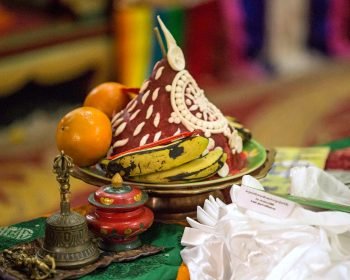
Tsog offering, India, February 2017. Photo by Paola Regis.
Rinpoche’s translation of Advice for the Anniversary of the Guru’s Passing Away sets out the benefits of making offerings, how to make offerings with six remembrances, and how to offer and dedicate the roots of virtue collected. Doing practices such as Lama Chopa with tsog is what is meant by “Making offerings on the anniversary of the guru’s passing away.” In other words, these offerings include offering tsog and are not just setting out a lot of water bowls, flowers, and so forth.
For more on Advice for the Anniversary of the Guru’s Passing Away, please see Rinpoche’s thought transformation teachings “Make Offerings on the Anniversary of Your Guru’s Passing Away” and “Make Offerings Thinking You Are Offering Them to Your Guru’s Pores.”
Rinpoche also recommends introducing new students to Lama Yeshe on Losar and taking time to remember him by watching videos of him teaching and reading stories about his life.
Find Advice for the Anniversary of the Guru’s Passing Away on the Foundation Store:
https://shop.fpmt.org/Advice-for-the-Anniversary-of-the-Gurus-Passing-Away-PDF-_p_3668.html
Find more advice from Lama Zopa Rinpoche on practices to do during Losar and the Fifteen Days of Miracles, please see:
https://fpmt.org/edu-news/practice-advice-and-rejoicing-for-losar-and-the-fifteen-days-of-miracles
Lama Zopa Rinpoche is the spiritual director of the Foundation for the Preservation of Mahayana Tradition (FPMT), a Tibetan Buddhist organization dedicated to the transmission of the Mahayana Buddhist tradition and values worldwide through teaching, meditation and community service.
- Tagged: advice from lama zopa rinpoche, lama chopa, losar, the hundred clear realizations of the glorious one from narthang
22
The Power of Mantra
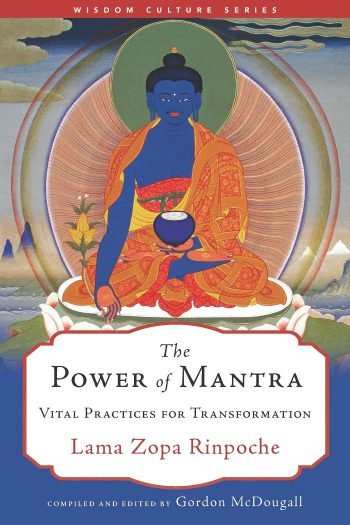
The Sanskrit word mantra (which is ngag in Tibetan) has two syllables: man, which means “mind,” and tra, which means “protect,” so a mantra is something that protects our mind.
The benefits of mantra recitation are vast. There are many stories about terrible diseases such as cancer being cured by mantras, or people or animals being helped to have a peaceful death and a positive rebirth through mantras being recited to them. But the supreme benefit of a mantra is its ability to transform our mind. When we recite a mantra such as Shakyamuni’s mantra, we are recalling the Buddha’s name over and over, helping us increase our closeness and devotion to the Buddha, and devotion is our real protection from suffering. By transforming our mind, it has the power to break negative habits and develop positive ones. As our mind changes, our ability to help others increases, so we are reciting mantras for others as well.
By linking us to the omniscient mind—the wisdom and compassion of the Buddha and all the enlightened beings—reciting a mantra invokes that great power, leading us from nonvirtue to virtue. The Buddha said,
Do not commit any nonvirtuous actions,
perform only perfect virtuous actions,
subdue your mind thoroughly—
this is the teaching of the Buddha.
The whole Buddhist path comes down to these two pieces of advice—to not harm others and to benefit them. In order to do that, we must subdue the mind, which means both collecting merit through doing only virtuous actions and purifying any negative imprints on our mindstream from negative actions we have done in the past.
Reciting a mantra such as OM MANI PADME HUM, the mantra of Chenrezig, is not only the most unbelievable purification—purifying defilements and negative karmas collected from not just this life but from beginningless rebirths—it also collects extensive merits.
In the West, when soccer players win, they throw their arms up in the air and run around. It’s very intense. When I first saw this, I thought they were very angry because of the strong emotion. If they feel that strongly about winning a match, we should feel a billion times more strongly about being able to purify all that negative karma and accumulate all that merit, simply by reciting a mantra.
Westerners have asked me many times to explain how mantras work. This is a question that comes from the Western mind; it’s not asked in Asia, certainly not among the Tibetans, because they have faith. When there is water, what does water do? It makes things wet; that is its nature. Fire has its own nature; its nature is to burn. Everything has its own nature. Mantras too have their own nature; their nature is to transform the mind. Any word we say affects another person’s mind, making them happy or sad or angry or whatever. The power of the mantra comes from the sound, and that sound has the power to transform the mind into one of virtue.
Thinking of mantras as just some Sanskrit sounds to be chanted is an extremely limited view of what they are; they are much more than that. The sound of a mantra has the power to protect us, holding our mind from nonvirtuous thoughts and fostering virtuous ones, thus allowing us to develop toward enlightenment. In the same way that the Dharma in general holds us, protecting us from suffering—Dharma literally means “that which holds”—mantras are mind protection. In A Guide to the Bodhisattva’s Way of Life, the great being Shantideva said,
Therefore, I should focus my mind correctly,
and keep a careful watch over it.
What good will it do to keep many vows,
if one neglects the vow of watching over the mind?
It is vital to remember Shantideva’s advice. If we forget to protect our mind, what is the use of any traditional form of discipline? Even though we may do hundreds of other things, if we leave out this most important practice and leave the mind unprotected, we cannot stop our problems and achieve happiness, especially ultimate happiness. Everything comes from the mind; it is the source of all our suffering and all our happiness, so if we neglect to protect our mind, we cannot close the door to suffering or open it to happiness.
In the West, there are so many external rules: you can’t do this, you can’t do that. Sometimes I think there are too many rules. When we rely on external discipline, we can never solve our problems. The discipline has to come from our own mind. As a Buddhist, we might take certain vows to protect ourselves from committing any of the ten nonvirtuous actions, but unless we protect our mind, those vows will be impossible to keep. As Shantideva said, what good will having vows be if we can’t watch over our mind?
Modern Western life is full of distractions. Everywhere are objects of the senses to keep our mind busy, enticing us away from the Dharma. If you check you will see this is true. Being preoccupied with working for this worldly life, as so many people are, makes it extremely difficult to remember the necessity of Dharma practice and to find the time to practice it. Buddhism has many methods to overcome a distracted mind, such as meditating on impermanence and death or on the disadvantages of the self-cherishing mind. When we are not meditating, however, what is the best method? Reciting mantras will keep our mind in virtue and protect it from nonvirtue.
From The Power of Mantra: Vital Practices for Transformation by Lama Zopa Rinpoche; compiled and edited by Gordon McDougall; published by Wisdom Publications (WisdomExperience.org), where you can order the paperback or digital versions of the book. You can also find the ebook and PDF version in the Foundation Store (shop.fpmt.org).
Lama Zopa Rinpoche is the spiritual director of the Foundation for the Preservation of Mahayana Tradition (FPMT), a Tibetan Buddhist organization dedicated to the transmission of the Mahayana Buddhist tradition and values worldwide through teaching, meditation and community service.
- Tagged: lama zopa rinpoche, mantras, wisdom publications
17
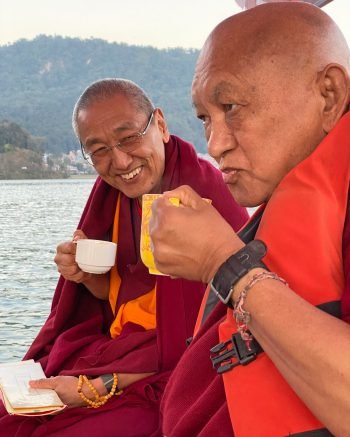
Rinpoche and Khen Rinpoche Geshe Chonyi, enjoying tea on the lake in Pokhara after blessing the sentient beings in the lake, Pokhara, Nepal, December 2021. Photo by Ven. Roger Kunsang.
We can do many things with our perfect human rebirth. Lama Zopa Rinpoche consistently reminds us to not waste this human rebirth but use it to develop compassion and help others. Here is an excerpt of Rinpoche’s teachings on this topic from “The Time to Practice is Now,” a detailed summary of the 2020 Thought Transformation Teachings given by Rinpoche. Then, following the excerpt, is a short video of Rinpoche teaching on this topic.
By reflecting on our own samsara and realizing that we have experienced oceans of suffering from beginningless rebirths, we develop strong renunciation wishing to be free from it. When we also think that others are suffering in the same way, we develop compassion for them, wishing them to be free from suffering. While we are just one, they are numberless—and they suffer just like us. We can’t imagine the different kinds of suffering that other beings experience. It is unbearable.
To generate compassion, we need to know the suffering of the six-realm sentient beings. For example, pretas, or hungry ghosts (a type of being), can’t find food or drink for tens of thousands of years. Due to their karma, even if they see water, their gaze dries the water up and it disappears. If they look at a green plant, it becomes bare and wilted. One type of preta has a mouth the size of the eye of a needle, but a stomach as big as a mountain. Even if they find food or drink, it cannot fill their stomachs. A second type of preta has flames coming from its mouth, and a third type has knots in its neck. These pretas all have unimaginable, unbearable suffering. One practice Rinpoche does often is making charity to these pretas by combining the practice with Dzambala offering, utilizing the offered water for the pretas.
As human beings, we cannot stand even small problems and difficulties. But these hardships are nothing compared to those experienced by animals. They cannot express themselves, so there is no one to help them. In addition, human beings, from presidents and billionaires down to beggars, do not really comprehend the feelings of animals. We kill thousands of animals every day for food. People not only eat them, but also make money from killing them and selling their meat and other body parts including skin and fur. People have the mistaken view that this is a good thing, that there is nothing wrong with it, that these beings are there for our pleasure. They never think about the suffering of the animals and that they also want happiness. They don’t realize that these beings, who have been their mother’s numberless times, are objects of compassion, not simply objects of pleasure.
We, therefore, need to develop compassion for animals and help them. There are many ways to benefit animals, who may suffer in the animal realm not just for this one lifetime, but for many eons. In his teachings, Rinpoche offers examples of how to cherish all sentient beings, including even the tiniest (and most irritating!) among us, such as mosquitoes. Some ideas of ways to benefit them include offering them blessed water or food, reciting prayers and mantras to them, playing sutras for them to hear, taking them around holy objects, and so forth. We can also build holy objects that animals can circumambulate to collect merit.
Wherever we go we can benefit sentient beings. For example, when we go to the beach, we can benefit all the animals in the ocean by dedicating our merits for them to never again be reborn in the lower realms and to be free from physical and mental sufferings, and for all of their wishes to succeed according to holy Dharma. Also, while at the beach, we can pray for human beings, wishing that anyone who even hears about the beach, sees the beach, or remembers the beach be free from all suffering and achieve all happiness, including enlightenment.
Watch the Essential Extract “How to Help Sentient Beings Say Goodbye to the Suffering of Samsara”:
In this video Essential Extract, Lama Zopa Rinpoche describes some of the ways in which he helps animals as well as people say goodbye to suffering. For example, in California, Rinpoche, together with sangha, goes to a pier over the ocean and dips a board, on which is carved the Namgyalma mantra, into the ocean. Before that, Rinpoche also recites mantras and blows on some water to bless it, and then pours the water in the ocean to purify the sentient beings living in it. Rinpoche also recites the long Chenrezig mantra and whenever he puts his feet in an ocean or lake, the water becomes blessed and anyone who is touched by it is purified. When Rinpoche goes to a beach, he makes prayers that anyone who comes to the beach, or even hears about or sees the beach, is never again reborn in the lower realms, that all their wishes succeed according to holy Dharma, and that they actualize bodhicitta and achieve enlightenment.
Read the transcript of this video extract from Rinpoche’s teaching:
https://fpmt.box.com/s/w2zmr2lgs6ag94xtccgcg4ua4nn6bsft
You can find more blogs with short video clips from Rinpoche’s teaching as well as the complete collection of these “Essential Extracts” videos on FPMT.org.
Lama Zopa Rinpoche is the spiritual director of the Foundation for the Preservation of Mahayana Tradition (FPMT), a Tibetan Buddhist organization dedicated to the transmission of the Mahayana Buddhist tradition and values worldwide through teaching, meditation and community service.
- Home
- News/Media
- Study & Practice
- About FPMT Education Services
- Latest News
- Programs
- New to Buddhism?
- Buddhist Mind Science: Activating Your Potential
- Heart Advice for Death and Dying
- Discovering Buddhism
- Living in the Path
- Exploring Buddhism
- FPMT Basic Program
- FPMT Masters Program
- FPMT In-Depth Meditation Training
- Maitripa College
- Lotsawa Rinchen Zangpo Translator Program
- Universal Education for Compassion & Wisdom
- Online Learning Center
- Prayers & Practice Materials
- Overview of Prayers & Practices
- Full Catalogue of Prayers & Practice Materials
- Explore Popular Topics
- Benefiting Animals
- Chenrezig Resources
- Death & Dying Resources
- Lama Chopa (Guru Puja)
- Lama Zopa Rinpoche: Compendium of Precious Instructions
- Lama Zopa Rinpoche: Life Practice Advice
- Lama Zopa Rinpoche Practice Series
- Lamrim Resources
- Mantras
- Prayer Book Updates
- Purification Practices
- Sutras
- Thought Transformation (Lojong)
- Audio Materials
- Dharma Dates – Tibetan Calendar
- Translation Services
- Publishing Services
- Teachings and Advice
- Find Teachings and Advice
- Lama Zopa Rinpoche Advice Page
- Lama Zopa Rinpoche: Compendium of Precious Instructions
- Lama Zopa Rinpoche Video Teachings
- ༧སྐྱབས་རྗེ་བཟོད་པ་རིན་པོ་ཆེ་མཆོག་ནས་སྩལ་བའི་བཀའ་སློབ་བརྙན་འཕྲིན།
- Podcasts
- Lama Yeshe Wisdom Archive
- Buddhism FAQ
- Dharma for Young People
- Resources on Holy Objects
- Ways to Offer Support
- Centers
- Affiliates Area
- Teachers
- Projects
- Charitable Projects
- Make a Donation
- Applying for Grants
- News about Projects
- Other Projects within FPMT
- Support International Office
- Projects Photo Galleries
- Give Where Most Needed
- FPMT
- Shop
Translate*
*powered by Google TranslateTranslation of pages on fpmt.org is performed by Google Translate, a third party service which FPMT has no control over. The service provides automated computer translations that are only an approximation of the websites' original content. The translations should not be considered exact and only used as a rough guide.Every second of this human life is more precious than skies of wish-granting jewels.


